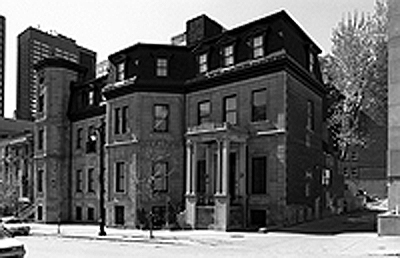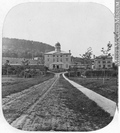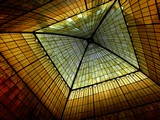
In 1886, Baron Alfred Baumgarten, a wealthy German sugar tycoon who generously donated to Montreal museums and hospitals and who loved horses and the hunt, designed a house for his family on McTavish Street. Three of the eight houses of Rupert's Terrace were demolished to make room for the Baumgarten house.  This mansion, located in the Golden Square Mile area of the city, was replete with detail and decoration in its sumptuous interior, although rather plain on the exterior. One of the outstanding features of this abode was the ballroom, built for Baumgarten'sdaughters who had just come of age. The ceiling, from which hung several chandeliers, was supported by marble columns, the floor was built on springs to help boost the dancers' feet, and a minstrel's gallery at one end was suspended from the ceiling with brass cords. The Gothic Gallery, which spanned two stories of the house, was made to resemble a German hunting lodge and was covered by an immense, amber-coloured, stained glass skylight.
This mansion, located in the Golden Square Mile area of the city, was replete with detail and decoration in its sumptuous interior, although rather plain on the exterior. One of the outstanding features of this abode was the ballroom, built for Baumgarten'sdaughters who had just come of age. The ceiling, from which hung several chandeliers, was supported by marble columns, the floor was built on springs to help boost the dancers' feet, and a minstrel's gallery at one end was suspended from the ceiling with brass cords. The Gothic Gallery, which spanned two stories of the house, was made to resemble a German hunting lodge and was covered by an immense, amber-coloured, stained glass skylight.

After Baron Alfred Baumgarten's death in 1919, the house was occupied by his family. McGill University purchased it in 1926 as a residence for Sir Arthur Currie, who had just become principal of McGill. In 1935, the house was renovated to become the McGill Faculty Club.  At this time, the Gothic Gallery was split into two separate floors, the lower floor, now serves as the main dining room, and the upper of which serves as the billiard's room, still covered by the original amber stained glass panels. The structure, and the other details in the interior have been preserved, and the aura of another century still pervades.
At this time, the Gothic Gallery was split into two separate floors, the lower floor, now serves as the main dining room, and the upper of which serves as the billiard's room, still covered by the original amber stained glass panels. The structure, and the other details in the interior have been preserved, and the aura of another century still pervades.